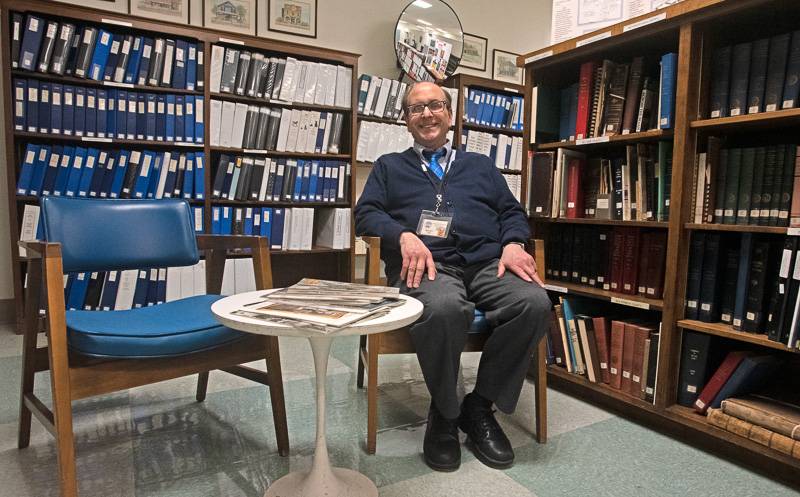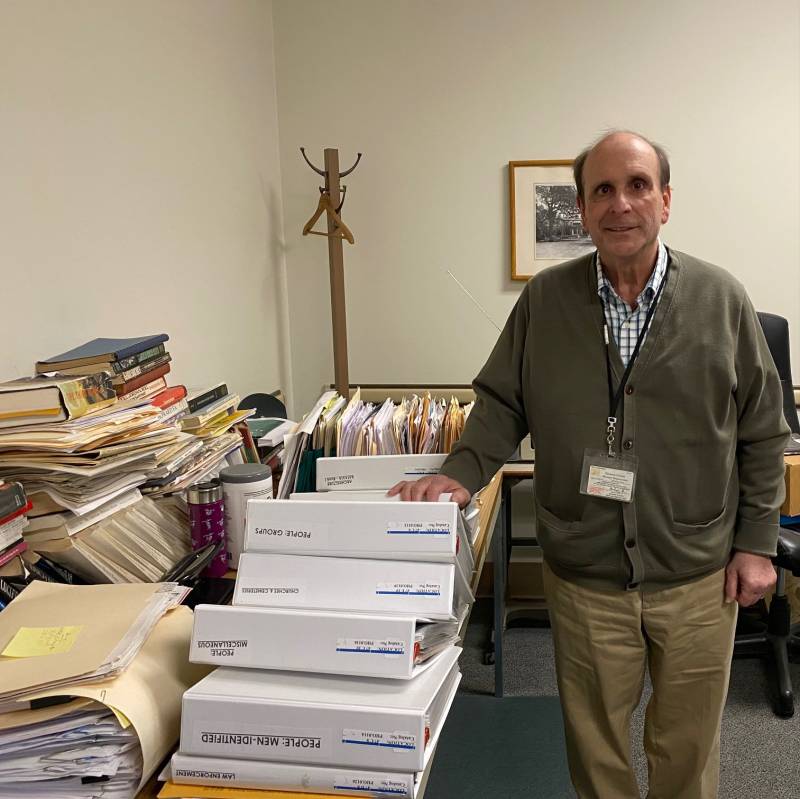'Historic Chronicles' debuts Monday, author talk and book-signing April 27

Photo by Howard Owens.
After talking to The Batavian in November 2023 about the premise and subject matter of his latest book, “Historic Chronicles of Genesee County,” county Historian Michael Eula will finally get to celebrate the official release on Monday.
The book is a twofer of sorts: it’s a local collection of essays on how American history affected Genesee County, and, per the stamp on the book’s jacket cover, it’s Made in the USA. Throw in assassinations, immigration, presidential politics and suffragists, and you’ve got a plethora of hot subjects as future reading material.
Eula said that one of his favorite chapters while working on the book was about the Cold War. While doing his research, he learned how much locals disagreed with the Korean War via letters to the editor in the local newspaper. He has also wondered—and examined—if all of society’s anxiety was really warranted during those Cold War days in which preparedness drills became more common.
“On Friday, Sept. 14, 1956, a civil defense exercise commenced at Batavia’s Veterans Administration Hospital.
At ten o’clock that morning, civil defense sirens blared, announcing a simulated fire raging in Ward D, part of a disaster test designed to recreate the conditions that would result from an explosion produced by an enemy attack. A second simulation that day include a nuclear attack that resulted in the destruction of the Batavia Post Office building. During this second simulated attack, a postal truck carried emergency supplies and equipment to a relocation site reached via West Main Street and Redfield Parkway. A second postal truck supervised by the foreman of mails, Arthur Norton, transported more people and equipment over Jefferson Avenue, Washington Avenue, Ellicott Avenue, Richmond Avenue and Redfield Parkway. A third postal truck remained on standby, while the Veterans Hospital supply officers, John Lane, ordered one truck to facilitate removal from what was left of the post office building while simultaneously keeping eight additional vehicles on standby. Officials drew on the help of volunteers responding to sirens located throughout the county.
In its Saturday edition, the Daily News reported that the exercise was an unqualified success. This drill serves as a stark reminder of the political and cultural realities of Cold War America in 1956 — and the anxiety regarding the possibility of a nuclear confrontation with the Soviet Union apparent in the county.
Why did a disaster produced by the enemy take place at all? Why was there a clear anxiety about its real possibility, who was this enemy and how could such an intrusion reach into the heart of an otherwise stable and peaceful Genesee County in 1956, Eula wrote.
He evaluates the situation in a section titled “What Happened and Why.” One line seems to answer it best: "The cultural preoccupation with a communist threat remained as apparent in Genesee County as it was in the nation at large. Local media continuously stressed the lethal quality of communist threats, subversion and attacks.”
Furthermore, “newspaper articles emphasized the necessity of American involvement in the Korean War, as evidenced by the participation of county residents in a conflict half a world away,” he wrote, using Batavia Daily News headlines in 1953, such as the one proclaiming “Airman from Oakfield Expects Duty in Korea,” as evidence.
“There were constant reminders of how hot the Cold War was capable of becoming and of how tragic the consequences were for some county families,” Eula said.
He cited the example of Private John V. Peca of Le Roy, who at 24 died during this time, leaving behind a wife, brother and parents, and whose remains were returned from Korea.
“Such stories abounded in the earlier years of the Cold War as the fighting raged in Korea,” Eula said. “Other accounts revealed that soldiers initially listed as missing in action subsequently reappeared as killed in action, as 18-year-old Army Corporal Norman F. Smart of Batavia. His brother, Private First Class Robert D. Smart, was also in Korea. While there, he suffered wounds.”
And those soldiers from the county that were not killed or wounded “sometimes languished as prisoners of war in communist prison camps,” he said.
“This, too, brought home to rural Genesee County residents the nation’s very real conflict with the communist world,” Eula said. “The many media accounts of those killed, wounded and mistreated by communists during a very hot Cold War period reminded readers of the threat posed by the communist world.”
There are six chapters in which Eula takes a swim in how national affairs affected locals at the time:
1. In Only Six Years: Genesee County Reacts to the Assassinations of The Kennedys and Martin Luther King Jr.;
2. Batavia Explodes: Cold War Anxiety and the Preparedness Drill of 1956;
3. Immigrants to White Ethnics;
4. Hoover, Roosevelt, and the New Deal in Genesee County;
5. In Western New York?: The Ku Klux Klan in Genesee County in the 1920s;
6. Activists, Farm Women, and Professionals
What illumination might a farm woman have to share? Genie Green’s mother wrote, on Jan. 24, 1887:
“There are periods in our lives when some new book or acquaintance comes to us like an added sun in the heavens, lighting the darkest places and chasing every shadow away.”
Eula noted that for many days after that entry, she spoke of drudgery in “doing odd jobs.” But then “an unexpected and particularly long entry appeared." On her 89th birthday, Genie’s mother wrote, “I can best honor it by consecrating myself to work for every good … for progressive thought and for moral and spiritual growth and development.”
“Much of her remaining diary entries exhibit much the same — her deep desire to light the dark places in a woman’s life,” Eula said.
When all was said and done, and documented and written — what was his conclusion at page 125?
“I started to write this book wondering where to begin. I now end it wondering where to stop,” Eula said. “There remains so much to write. Nonetheless, I consciously selected areas of the county’s past serving to illuminate the reality faced by people living there. This is admittedly not a traditional history, as I did not confine myself exclusively to events or to an orderly chronological span of time.
“Genesee County’s history is a long stretch of time punctuated by specific realities. Those realities were influenced by the national events addressed in this book. In turn, local perceptions of those events shaped the understanding of nationwide phenomena,” he said. “There was an underlying continuity in the county’s history. While much changed since 1802, much also remained the same. The history of the county remained anchored in a belief in individual liberty. The enlargement of individual liberty was viewed as the cornerstone of a good life.”
The History by the Hearth series will feature Eula from 1:30 to 3 p.m. April 27 at Richmond Memorial Library, 19 Ross St., Batavia.
He will read from the book, and a book signing will follow. The book will be available for purchase before and on the day of the event.
His book may also be purchased at Holland Land Office Museum and online at Barnes and Noble and Amazon. In addition to being the county historian, Eula is also Professor Emeritus of History at El Camino College. He is the author of more than 30 articles and books in American and European history, including “Between Peasant and Urban Villager: Italian-Americans of New Jersey and New York, 1880 to 1980--The Structures of Counter-Discourse.”
He was named a National Endowment for the Humanities Fellow three times, and received the DeAngelis Prize in History in 2000. He is an honors graduate of Rutgers and the Regent University School of Law, where he received an LLM degree. He holds an MA and a PhD in history from the University of California-Irvine.

